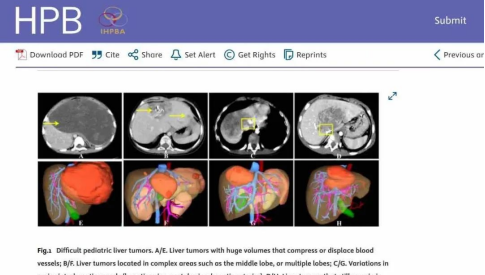Recently, the "International Expert Consensus on the Clinical Application of Three-Dimensional Visualization Technology in the Precision Surgical Treatment of Pediatric Liver Tumors" written by Dong Qian, the first author and corresponding author, along with 36 top medical experts from 34 medical institutions across eight countries including China, the United States, Japan, Germany, the United Kingdom, South Korea, Australia, and Canada, was officially published in a top international journal in hepatobiliary and pancreatic medicine———“HPB”. This marks a new phase in the precision surgical treatment of pediatric liver tumours and provides authoritative guidance for the diagnosis and treatment of global pediatric liver tumours.

Pediatric liver tumours are a rare but hazardous category of childhood cancers, primarily including hepatoblastoma, hepatocellular carcinoma, and hepatic hemangioma. Traditional surgical treatments rely on two-dimensional imaging (such as CT or MRI) and the surgeon's experience, making it difficult to fully visualize the spatial relationships between the tumour and critical structures such as liver vessels and bile ducts. For pediatric patients, whose livers are small and anatomically delicate, even minor deviations can lead to severe complications. Particularly for complex pediatric liver tumour cases, traditional surgical methods often face significant challenges. Achieving precise tumour resection and maximizingly preserving the healthy liver tissue has become a major challenge in pediatric liver tumour treatment.

With the deepening of precision medicine concepts and advancements in medical technology, the treatment of pediatric liver tumours has gradually shifted from "empirical medicine" to "precision medicine." The core of precision surgical treatment lies in using advanced technological methods to achieve accurate preoperative assessment, precise intraoperative operations, and meticulous postoperative management, thereby improving surgical success rates, reducing complication rates, and enhancing patient outcomes.
Three-dimensional visualization technology has been a breakthrough in medical imaging in recent years. Reconstructing two-dimensional medical imaging data into three-dimensional models, helps clinicians better understand the size, location, and morphology of tumours and their spatial relationships with surrounding structures such as blood vessels and bile ducts. This technology holds significant value in the precision surgical treatment of pediatric liver tumours.
Dong Qian, a National Distinguished Physician, a Taishan Scholar Climbing Expert, Director of the Shandong Provincial Key Laboratory of Digital Medicine and Computer-Assisted Surgery, President of the Institute of Digital Medicine and Computer-Assisted Surgery at Qingdao University and Professor of Pediatric Surgery at the Affiliated Hospital of Qingdao University, has long been dedicated to research on the application of three-dimensional visualization technology in pediatric liver tumours. He pioneered the development of the "Computer-Assisted Surgery System for Pediatric Hepatobiliary and Pancreatic Surgery," a series of medical devices widely used in clinical practice. He also established an open platform for the Human Digital Liver Database, innovated liver segmentation classification, proposed standard liver volume for children, and integrated microscopic pathological 3D with macroscopic imaging 3D to create a precision surgical system for pediatric liver tumours that is visualizable, quantifiable, individualized, and refined. Additionally, he developed a cloud-based platform for precision surgery using three-dimensional visualization, extending its application to adult patients nationwide, providing 3D reconstruction services to over 51,000 adult and pediatric patients across 326 hospitals. His related research findings have been included in the "Diagnostic and Treatment Guidelines for Pediatric Hepatobiliary Surgical Diseases", "Pediatric Surgical Oncology", "Pediatric Hepatobiliary Surgery", and three English-language international monographs, as well as the "Classic Surgeries of Contemporary Chinese Medical Masters". He was awarded the Second Prize of the National Science and Technology Progress Award in 2019.
This successful publication of the "International Expert Consensus on the Clinical Application of Three-Dimensional Visualization Technology in the Precision Surgical Treatment of Pediatric Liver Tumors" is the representation of many years of research by Professor Dong Qian's team and serves as a model for international multicenter collaboration. This consensus covers all aspects of the application of three-dimensional visualization technology in the diagnosis and treatment of pediatric liver tumours, including imaging data acquisition, 3D model reconstruction, preoperative planning, intraoperative navigation, and postoperative assessment, providing a systematic operational guide for clinicians worldwide. It is of great significance for improving the accuracy of preoperative evaluation, enhancing intraoperative guidance, promoting multidisciplinary collaboration, and advancing individualized treatment.
The consensus development process fully reflects the scientific rigour of international collaboration. It was jointly developed by 36 top experts in paediatrics, pathology, surgical training and education, and computer science, undergoing multiple rounds of discussion and revision before reaching a unanimous agreement. Although three-dimensional visualization technology has been applied in adult liver surgery, its systematic research in the pediatric field has been lacking. This consensus is the first to provide scientific guidance tailored to the unique needs of pediatric patients.
Currently, while three-dimensional visualization technology has shown great potential in the precision surgical treatment of pediatric liver tumours, it still faces challenges. For example, the implementation of this technology requires high-precision imaging equipment and specialized software, placing higher demands on the hardware capabilities and technical expertise of medical institutions. The application of three-dimensional visualization technology has turned the concept of precision surgery into reality. As the technology continues to improve and clinical data accumulates, three-dimensional visualization technology is expected to become a "standard" in pediatric liver tumour surgery, further enhancing the survival rates and quality of life for young patients.